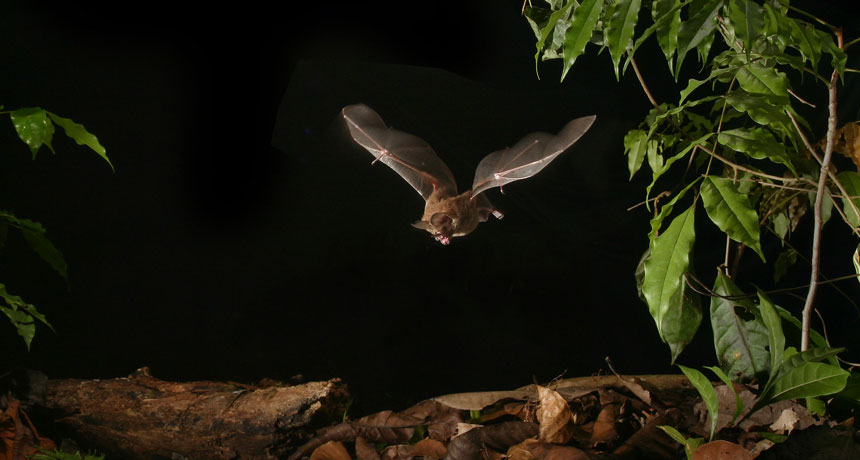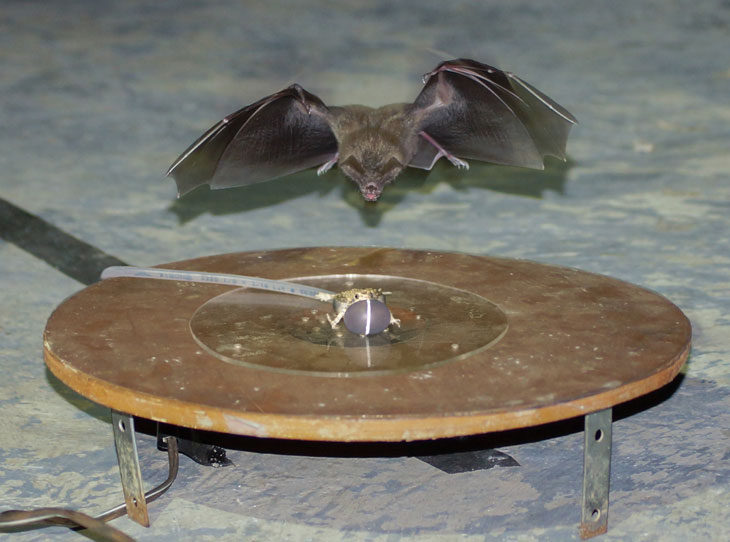Frog-hunting bats have ‘cocktail party effect’ workaround
In noisy environment, hunters shift from listening for croaks to using echolocation

NIGHT STALKER A fringe-lipped bat, which hunts frogs by listening for their nighttime calls, has ways of compensating when unnatural human noises get in the way.
Alex Lang
An experiment with fake frogs shows how certain bats adjust their hunting technique to compensate for unnatural noises.
Humankind is loud, and research already suggests that birds alter their singing in urban noise. Now tests show that bats listening for the frogs they hunt switch from mostly quiet eavesdropping to pinging echolocating when artificial sounds mask the frog calls. That way, the bats can detect the motion of the frogs’ vocal sac poofing out with each call, researchers report in the Sept. 16 Science.
That switch in sensory tactics could make bats the only animals besides people shown to react this way to interfering din in the classic cocktail party scenario, says study coauthor Wouter Halfwerk of Vrije University Amsterdam. People straining to hear each other over the cacophony of a party can get a boost in communication by paying attention to each other’s mouth movements. He points out that watching someone’s lips lets people tolerate about an extra 20 decibels of tipsy shrieking and shouting.
Conservation biologists worry about the effects of human racket on other residents of the planet. Other researchers, for instance, found that noise interfered with pallid bats’ success in hunting insects on the wing. The fringe-lipped bats (Trachops cirrhosus) in the new study, however, specialize in frogs instead of insects. Hungry bats listen to frog choruses and swoop out of the darkness to carry off a male chirping his advertisements for a mate. “A talking pickle” is what Halfwerk calls the frog.

In this setup, interfering noise changed normal hunting. When researchers broadcast sounds that partially masked the main frequency of telltale frog calls, bats waited longer than normal to strike and also strongly preferred pouncing on a robofrog that was inflating his sac instead of an identical frog squatting nearby with a deflated sac. Recordings of bat noises from the perch showed that the hunters were pinging fast echolocation sounds instead of mostly listening for the pickle to betray its location.
Even with the strategy switch, the bats aren’t completely making up for the noise nuisance, Jinhong Luo at Johns Hopkins University points out. A sensory biologist, he has tested noise effects on other bats but was not involved in this project. Looking at the new data, he notes that frog-eating bats in echolocating mode are slower to leave their perches and swoop than bats in eavesdropping mode. He also cautions about generalizing to the other 1,300-plus bat species. Many of them are already using echolocation to hunt insects and may not have a backup prey-finder method when noise complicates their foraging.







